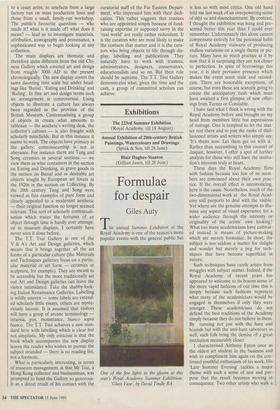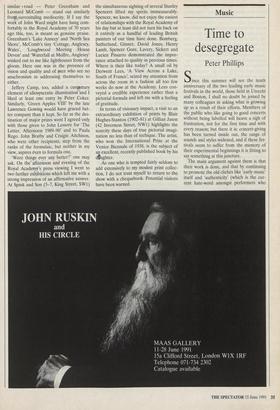Exhibitions
Annual Exhibition of 20th-century British Paintings, Watercolours and Drawings (Spink & Son, till 28 June)
Formulae for despair
Giles Auty
The annual Summer Exhibition at the Royal Academy is one of the season's more popular events with the general public but One of the few lights in the gloom at this year's Royal Academy Summer Exhibition: 'Glass Vase', by David Tindle RA is less so with most critics. One old hand told me last week of an overpowering sense of déjà vu and disenchantment. By contrast, I thought the exhibition was hung and pre- sented better this year than I could ever remember. Unfortunately this alone cannot compensate entirely for the perennial habit of Royal Academy stalwarts of producing endless variations on a single theme or pic- ture. Many have so much practice at it by now that it is surprising they are not closer to perfection. In spite of borrowings this year, it is their pervasive presence which makes the event seem stale and second- rate. There are honorable exceptions, of course, but even these are scarcely going to create the anticipatory hush which must have awaited a first glimpse of new offer- ings from Turner or Constable.
I have said what I think is wrong with the Royal Academy before and brought on my head from members little but expressions of outrage. One is tempted to let the mat- ter rest there and to join the ranks of disil- lusioned artists and writers who simply say, It's theirs now. Let them get on with it.' Rather than succumbing to this counsel of despair, however, I offer a spot of further analysis for those who still have the institu- tion's interests truly at heart.
These days the Royal Academy flirts with fashion because too few of its mem- bers are convinced about their own prac- tice. If the overall effect is unconvincing, here is the cause. Nonetheless, much of the two-dimensional work at the Royal Acad- emy still purports to deal with the visible. Yet where are the genuine attempts to illu- mine any aspect of visual experience for a wider audience through the intensity or originality of the artists' own looking? What too many academicians have cultivat- ed instead is means of picture-making which are merely formulaic. In short, the subject is too seldom a matter for delight and wonder but merely a peg for tech- niques that have become superficial in nature.
Such techniques have rarely arisen from struggles with subject matter. Indeed, if the Royal Academy of recent years has appeared to welcome to its bosom some of the more vapid fashions of our time this is simply because such fashions represent what many of the academicians would be engaged in themselves if only they were younger. These academicians do not defend the best traditions of the Academy simply because they do not believe in them. By running not just with the hare and hounds but with the anti-hunt saboteurs as well, such folk bring the demise of a great institution measurably closer.
I characterised Anthony Eyton once as the oldest art student in the business and wish to compliment him again on the con- tinued youthful enthusiasm of his work. His 'Late Summer Evening' tackles a major theme with such a sense of zest and pur- pose that the result becomes moving in consequence. Two other artists who walk a similar • road — Peter Greenham and Leonard McComb — stand out similarly frorgourrodnding mediocrity. If I say the work of John Ward might have hung com- fortably in the Royal Academy of 70 years ago this, too, is meant as genuine praise. Greenham's 'Lake Annecy' and 'North Sea Shore', McComb's tiny 'Cottage, Anglesey, Wales', `Loughwood Meeting House Devon' and 'Waterfall at Molfre, Anglesey' winked out to me like lighthouses from the gloom. Here one was in the presence of vision and quality and of men who see no anachronism in addressing themselves to either.
Jeffery Camp, too, added a custAmary element of idiosyncratic illumination I liked at least one entry by Peter Coker. Similarly, 'Green Apples VIII' by the late Lawrence Gowing would have graced bet- ter company than it kept. So far as the des- tination of major prizes went I agreed only with those given to John Lessore for 'The Letter, Afternoon 1989-90' and to Paula Rego. John Bratby and Craigie Aitchison, who were other recipients, step from the ranks of the formulaic, but neither in my view, aspires exen to formula one.
'Were things ever any better?' one may ask. On the* affernoon and evening of the Royal Academy's press viewing I went to two further exhibitions which left me with a strong impression of an affirmative answer. At Spink and Son (5-7, King Street, SW) the simultaneous sighting of several Stanley Spencers lifted my spirits immeasurably. Spencer, we know, did not enjoy the easiest of relationships with the Royal Academy of his day but at least did not turn his back on it entirely as a handful of leading British painters of our time have done. Bomberg, Sutherland, Ginner, David Jones, Henry Lamb, Spencer Gore, Lavery, Sickert and Lucien Pissarro demonstrated the impor- tance attached to quality in previous times. Where is their like today? A small oil by Derwent Lees, 'A View Across a Lake, South of France', seized my attention from across the room in a fashion all too few works do now at the Academy. Lees con- veyed a credible experience rather than a pictorial formula and left me with a feeling of gratitude.
In terms of visionary impact, a visit to an extraordinary exhibition of prints by Blair Hughes-Stanton (1902-81) at Gillian Jason (42 Inverness Street, NW1) highlights the scarcity these days of true pictorial imagi- nation no less than of techique. The artist, who won the International Prize at the Venice Biennale of 1938, is the subject of a2 excellent, recently published book by his Mighter.
As one who is tempted fairly seldom to add extensively to my modest print collec- tion, I do not trust myself to return to the show with a chequebook. Potential visitors have been warned.



















































 Previous page
Previous page